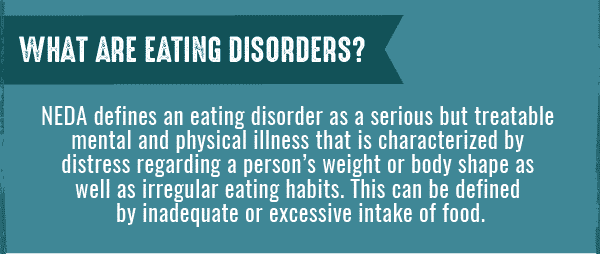All about Eating Disorder Recovery
Wiki Article
Eating Disorder Recovery Things To Know Before You Buy
Table of ContentsUnknown Facts About Eating Disorder RecoveryThe Best Strategy To Use For Eating Disorder RecoveryGetting My Eating Disorder Recovery To WorkThe Ultimate Guide To Eating Disorder RecoveryHow Eating Disorder Recovery can Save You Time, Stress, and Money.

ARFID is frequently considered a severe form of particular eating. Some youngsters are picky eaters and might be diagnosed with ARFID due to the fact that they don't eat sufficient calories to create as well as grow. Grownups can be diagnosed with ARFID also, and along with not developing literally, they may have difficulty with keeping fundamental physical functions.
Rumination problem is an eating disorder that entails on a regular basis spitting up food. As soon as spit up, the food might be re-chewed, re-swallowed or spit out. Somebody with rumination problem doesn't show up to do this purposefully. Nonetheless, a person with rumination condition is additionally unlikely to appear troubled, dismayed or disgusted by their regular regurgitation.
Eating Disorder Recovery for Dummies
People who are identified with rumination eating condition are regularly educated to change the regurgitation with deep breathing strategies. Orthorexia nervosa is not yet an identified eating problem diagnosis.Orthorexia is defined as a fascination with consuming healthy food and staying clear of undesirable food. A person with orthorexia is most likely to experience some impairments in their life due to their fixation with healthy consuming.
Like orthorexia, diabulimia is not yet an officially identified eating condition. Diabulimia is a serious and also potentially deadly problem. Understanding specifically what diabulimia is can help determine individuals who are battling with this disorder as well as might also go to risk of establishing various other eating conditions. Diabulimia describes the intentional adjustment of insulin levels by a person with kind 1 diabetes mellitus to set off severe weight management.
Unknown Facts About Eating Disorder Recovery
Other Specified Feeding or Eating Condition, extra frequently referred to as OSFED, was previously recognized as Eating Disorder Not Otherwise Specified (EDNOS). An OSFED eating disorder might not satisfy the analysis criteria for other eating conditions however is nevertheless major and potentially deadly. OSFED refers to a condition that has the general features of anorexia nervosa or bulimia Does not fulfill the full diagnostic standards for either of these problems.An individual with an OSFED is equally as likely to have serious clinical consequences as individuals that fully fit an eating problem diagnosis. Someone who has official statement an OSFED may be equally as likely to pass away as a result of disordered consuming as any person else with an eating condition. Consuming disorders might be triggered by co-occurring psychological health problems and can create physical conditions that can be serious.
Acknowledging the very early warning signs of consuming disorders can make a significant difference in the lasting wellness impacts triggered by the problem. Signs as well as symptoms of eating problems can be normally split into 2 sub-categories: behavioral (as well as psychological) indicators and also physical signs. Usual psychological and behavior indications of an eating condition may not always be quickly identifiable.
The 4-Minute Rule for Eating Disorder Recovery

In situations where common behavioral as well as emotional symptoms are unable to be observed, a medical professional may recognize an eating disorder solely based upon physical indicators (eating disorder recovery). Some usual physical signs and symptoms of an eating problem consist of: Obvious changes in weight (both gains as well as losses)Stomach cramps, Bowel irregularity, Indigestion, Menstruation abnormalities, including loss of periods or missed durations, Difficulty Your Domain Name focusing or receiving focus, Lightheadedness or fainting, particularly after standing up, Resting issues, Cuts and calluses on fingers, Oral issues like enamel erosion, cavities and also tooth sensitivity, Dry skin, hair and nails Like various other mental health and wellness conditions, consuming conditions are triggered by a mix of ecological, genetic and also social aspects.
An inefficient hormonal action to tension might recommend a sensitivity to developing an eating problem. Social scenarios associated with sporting activities, modeling or various other professions concentrating on body picture and weight control might affect the advancement of consuming disorders. The National Partnership on Mental Disease records that individuals are even more most likely to establish an eating problem if one of their instant household members has one.
4 Simple Techniques For Eating Disorder Recovery
Warning signs vary from person to person, but some variables are likely to affect a person's danger of establishing an eating condition (eating disorder recovery). Some biological risk elements that apply to people with anorexia nervosa, bulimia nervosa or binge eating condition include: Having a member of the family with an eating problem, Having a relative with one more mental health disorder Perfectionism, Body photo frustration, Background of an anxiousness disorderInflexible reasoning Weight stigma, Background of diet programs, Being teased or harassed, Limited go to my blog social networks, History of injury Similar to various other mental health problems, consuming conditions and dependencies often co-occur.In addition, up to 35 percent of individuals with substance usage conditions additionally had an eating condition.
Report this wiki page